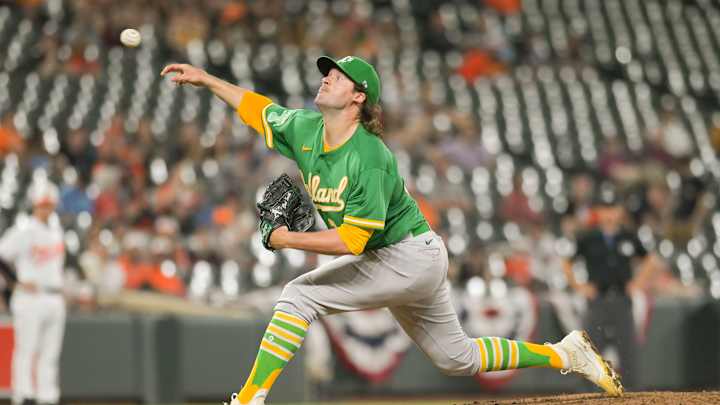A's Chad Smith Talks Pitching

Chad Smith was traded to the Oakland A's back on December 6 in a deal that flew under the radar to most observers. Smith came to the A's with a career 7.50 ERA in 18 big-league innings with the Colorado Rockies. He'd also issued 15 walks in those 18 innings.
But Smith also came with a lethal slider.
Last season that slider had a 56% whiff rate and was used roughly 32% of the time, with his sinker accounting for 66% of his pitches, and the seven changeups he threw making up the rest of his pitch mix.
Heading into Monday's outing against the Cubs, the whiff rate on his slider was holding steady at 55%. He worked 1.1 innings in that outing, allowing one hit and needing just 18 pitches.
After a solid spring, Smith was optioned down to the minors. Smith said that the message he received was that the decision wasn't based on performance, but that they needed an extra long guy with the way that the rotation was going to work.
"It made sense, but at the same time it was tough to hear. It was something that I wanted really bad, and getting that news was tough. But that's the profession we're in, so you just gotta put your head down and keep going. Go to Triple-A, make the best of the situation, and that's what I tried to do."
With the Aviators the 27-year-old righty got into three games, pitched four innings, and held a 2.25 ERA with six strikeouts and four walks.
Since his return to the big leagues, Smith has been getting a few extra inches of horizontal movement on his sinker this season. The 3.3 inches of movement (vs. average) he's getting is tied for 6th among all pitchers with a sinker this season. Last year that same pitch was -0.5 inches of horizontal movement below average.
I asked him if he'd been working with a new grip.
"The sinker, we're changing very, very little of the way the ball is in my hand, but not much. Hardly any at all, depending on the day."
Smith says the slider needs to work for him to be successful.
"On the breaking ball, I hold it the same way, but it's just trying to shape it different in different counts to different sides of the plate. Sometimes I'll try to cut it more horizontally, like into a lefty so it's not the 'depthy' one. It honestly depends on how my two-seam is moving that day. If my two-seam is running more, then I'll try to cut the slider more to try to tunnel them. And then when it gets later in the count I might try to throw one that [has] a little bit more depth and try to get a swing and miss.
It just depends on the count, the hitter, righty/lefty, the situation of the game. It doesn't always move the way you want it to every time, but the intent is there."
If that wasn't nerdy enough for you, I also asked Chad to take me inside the thought process of when to throw the slider and how often. For such an effective pitch, he used it 32% of the time with Colorado, and that's up to 35% this season in six MLB innings.
"It's hard to be a one pitch guy. For me, I think the shorter the break is on the slider, the more effective it is for me because my two-seam is moving a good amount. I can see myself throwing it more often, but it depends on the situation of the game. If I have to go longer in an outing, and it's not feeling great that day, just try to fill the zone. I don't worry so much about hitting spots as just trying to fill the zone and let my defense work. Try to be efficient.
Later in games, tighter games, leverage counts, leverage situations, the slider will probably be more used for sure."
Smith has appeared in three games out of the Oakland 'pen since being recalled on April 12, notching his first career win in his first outing in Baltimore. He has allowed six hits, one run, issued zero walks, and struck out four in six frames. He has a 1.50 ERA and a 1.00 WHIP.
